Categories: Electrician at home, Electrical Reviews
Number of views: 161,275
Comments on the article: 5
Dimmers: device, varieties and connection methods
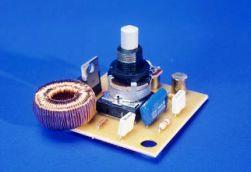 Dimmers (dimmers for light control) - This is a miniature device that is installed instead of the usual, standard mechanical switch, allowing smoothly adjust brightness artificial lighting.
Dimmers (dimmers for light control) - This is a miniature device that is installed instead of the usual, standard mechanical switch, allowing smoothly adjust brightness artificial lighting.
The first, a mechanical dimmer, was invented in the 1890s to slowly darken theater lighting. The primacy of this invention belongs to the inventor - self-taught, an ardent fan of Melpomene from the United States, Granville Woods.
All dimmers are designed to turn on / off the lighting and adjust its intensity. In addition, many models provide other useful features. For example, automatic shutdown by timer, imitation of presence (on, off, brightness change according to the program), soft shutdown, remote control, acoustic or voice control, connection to unified network "smart home".
Before you start choosing a dimmer, you need to decide what exactly you would like, i.e. what range of services you would like to receive from the device, determine the place of installation of the dimmer and its intended use.
Modular dimmers
In appearance, modular dimmers are very similar to circuit breakers and mean electrical installation in switchboards on a DIN rail. They can be used with incandescent lamps and halogen lamps with step-down transformers.
Modular dimmers are mainly used to control lighting on stairwells and in corridors. Dimmers of this type are controlled separately by a button or a conventional single-key switch.
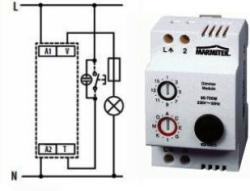
Mounting box dimmers
The execution of such dimmers is evident from the name, it is installed in the same box as switches and sockets. These dimmers are usually used with incandescent lamps, halogen lamps with step-down transformer (inductive load) and with halogen lamps with electronic transformer (capacitive load). Such dimmers are controlled by a button that is put in a box on top of the installed device.
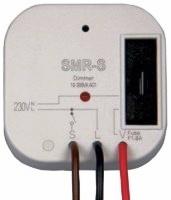
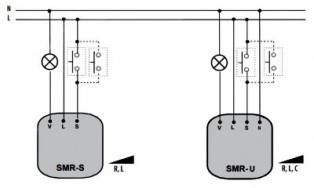
Monoblock dimmer
It is usually executed as a single unit for installation in a mounting box like a conventional switch. For the electrical installation of this dimmer, you will need an installation slot for a mounting box of 26 mm or more, depending on the model. It is very convenient to use in thin partitions, where the wall thickness, or other reasons, does not allow you to install a standard standard switch. Used models such as devices of the previous type.
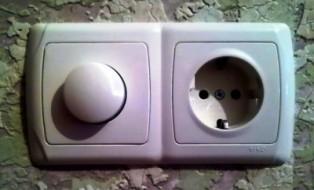

The main difference is that devices of this type have a two-wire connection. They are included in the breaking of the phase load circuit. Devices of this type have a wide variety of external designs, both in terms of design and in terms of color gamut.
Monoblock dimmers, in turn, may differ in the execution of the control part:
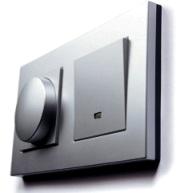 1. Rotary-push dimmers are triggered by pressing the key, the adjustment is made by rotating it.
1. Rotary-push dimmers are triggered by pressing the key, the adjustment is made by rotating it.
2. Rotary dimmers, all control is performed exclusively by turning the knob. The disadvantage of such a solution is that it is impossible to store in the memory the value of the illumination for starting, the Start always occurs with a minimum brightness.
3. Key dimmers in appearance are practically indistinguishable from conventional switches. When pressed, it turns on / off, and when you hold the key for more than 3 seconds. and the adjustment takes place directly.
4. Touch switchesare a more advanced type of device. All control is performed without moving parts, and therefore more reliable.Manage such models by touching the touch panel.
Now a little about the cons, so to speak - pitfalls.
If you plan to load your dimmers with fluorescent, or energy saving lamps, you are very at risk of getting extra costs, since fluorescent and energy-saving lamps are not dimmed.
There are cases of “lo and behold”, such a spark - a dimmer / energy-saving lamp seems to work. In fact, the lamp life in this mode is reduced to 100 - 150 hours, the dimmer due to constant overload "live" not much longer.
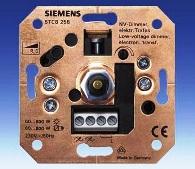 Of course, there are pleasant exceptions to any rule, for example, lamps from the Polish company Godiva, which start at about 15% brightness, but these lamps cost about 20 - 25 euros and this only confirms this rule. Yes, and phase-cut dimmers used for such lamps, of course, are produced, for example, devices from Jung, Gira, Legrand and others, but they cost the same, respectively, from $ 100.
Of course, there are pleasant exceptions to any rule, for example, lamps from the Polish company Godiva, which start at about 15% brightness, but these lamps cost about 20 - 25 euros and this only confirms this rule. Yes, and phase-cut dimmers used for such lamps, of course, are produced, for example, devices from Jung, Gira, Legrand and others, but they cost the same, respectively, from $ 100.
All dimmers require a minimum load. Usually it is about 40 watts. When the load decreases, which can be caused by various factors, for example, one of the lamps burns out, contact worsens, etc., a flicker of the load appears at a frequency of about 50 Hz, sometimes accompanied by a buzz of the same frequency.
With an even more significant decrease in load, the device protection system is activated, or the dimmer fails. In practice, it is often solved by installing in parallel with the main load, incandescent lamps with a power of 40 watts or more.
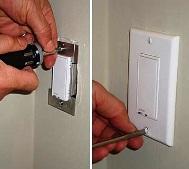 Dimmers are critical to ambient temperature. When the temperature rises above 25 0С, close attention should be paid to the temperature regime of the device; an overheated device in case of protection failure easily fails. In no case is it recommended to exceed the maximum load of a particular device. The problem of lack of power can be solved by adding power amplifiers, usually they allow switching devices up to 1.8 kW.
Dimmers are critical to ambient temperature. When the temperature rises above 25 0С, close attention should be paid to the temperature regime of the device; an overheated device in case of protection failure easily fails. In no case is it recommended to exceed the maximum load of a particular device. The problem of lack of power can be solved by adding power amplifiers, usually they allow switching devices up to 1.8 kW.
A dimmer must be used exactly with the type of load for which it is designed. Moreover, less universal devices in terms of load are more reliable. Another very important point, it is not allowed to connect at the same time loads of an inductive and capacitive nature, this can lead to device failure!
With the indisputable advantage of the dimmer in the ability to switch the lighting to the "night" mode, in the children's room or in the corridor, the "night" mode, these devices at low capacities show very low efficiency.
Addition, badges and symbols on dimmers:
 Either the Latin letter “R” means that the device is designed to work with incandescent lamps, with the so-called “Ohm”, or “Resistive” load.
Either the Latin letter “R” means that the device is designed to work with incandescent lamps, with the so-called “Ohm”, or “Resistive” load.
 Or the Latin letter "L" means that the device allows operation with transformers, the so-called "Inductive" load.
Or the Latin letter "L" means that the device allows operation with transformers, the so-called "Inductive" load.
 Or the Latin letter "C" means that the device allows operation with electronic transformers, the so-called "Capacitive" load.
Or the Latin letter "C" means that the device allows operation with electronic transformers, the so-called "Capacitive" load.
 The lamp allows dimming, is placed on fluorescent and energy-saving lamps.
The lamp allows dimming, is placed on fluorescent and energy-saving lamps.
We express our deep hope that the information provided in this article will facilitate your choice of a lighting control system for maximum convenience and comfort in your home.
Look on the topic:
See also at e.imadeself.com
:
